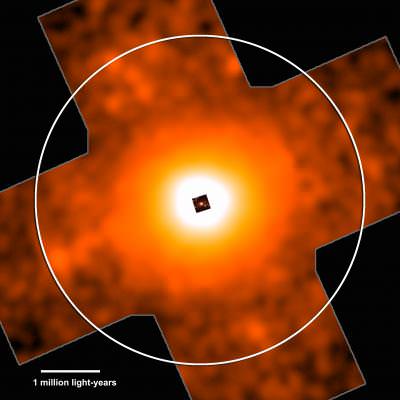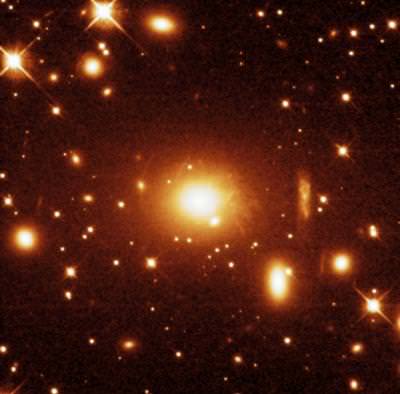[/caption]
An international team of astronomers has mapped the density and temperature of X-ray-emitting gas in the outskirts of a distant galaxy cluster. The results, obtained with the orbiting Japanese X-ray telescope Suzaku, give the first complete X-ray view of a galaxy cluster, and provide insight into how such clusters come together.
“These Suzaku observations are exciting because we can finally see how these structures, the largest bound objects in the universe, grow even more massive,” said Matt George, the study’s lead author at the University of California, Berkeley.
The team trained Suzaku’s X-ray telescopes on the massive galaxy cluster PKS 0745-191, which lies 1.3 billion light-years away in the southern constellation Puppis. Between May 11 and 14, 2007, Suzaku acquired five images of the million-degree gas that permeates the cluster.
The X-ray images of the cluster helped astronomers measure the temperature and density of the gas. These provide clues about the gas pressure and cluster’s total mass. The hottest, densest gas lies near the cluster’s center, while gas temperature and density steadily decline away from the center.
Astronomers believe the gas in the inner part of a galaxy cluster has settled into an ordered “relaxed” state in equilibrium with the cluster’s gravity. But in the outer regions, where galaxies first begin a billion-year plunge towards the cluster’s center, the gas remains in a disordered state because it’s still falling inward.
“Clusters are the most massive, relaxed objects in the universe, and they are continuing to form now,” said team member Andy Fabian at the Cambridge Institute of Astronomy in the UK.
For the first time, this study shows X-ray emission and gas density and temperature out to the region where the gas is disordered, and where the cluster continues to assemble.
“It gives us the first complete X-ray view of a cluster of galaxies”, said Fabian.

In PKS 0745-191, the gas temperature peaks at 164 million degrees Fahrenheit (91 million C) about 1.1 million light-years from the cluster’s center. The temperature declines smoothly with distance, dropping to 45 million F (25 million C) more than 5.6 million light-years from the center.
To accurately measure X-ray emission at the cluster’s edge requires detectors with exceptionally low background noise. Suzaku has advanced X-ray detectors, and it lies in a low-altitude orbit near the Earth’s magnetic field, which protects the observatory from energetic particles from the sun and beyond.
“With more Suzaku observations in the outskirts of other galaxy clusters, we’ll get a better picture of how these massive structures evolve,” added George.
Suzaku (Japanese for “red bird of the south”) was launched on July 10, 2005. The observatory was developed at the Japanese Institute of Space and Astronautical Science (ISAS), which is part of the Japan Aerospace Exploration Agency (JAXA), in collaboration with NASA and other Japanese and U.S. institutions.
The results were published in the May 11 edition of the Monthly Notices of the Royal Astronomical Society.
Source: NASA


Quite interesting 😉
I’m sorry, but what exactly do you mean? The caption reads: “11.2 million light-years across”. If this is the diameter then it does not correspond to the bar in the picture. With its scale I get a diameter of about 5 million ly. Or do I get it wrong and “across” refers to the perimeter?
Yes, interesting.
“Clusters are the most massive, relaxed objects in the universe”
So can we say that there are no larger structures, say clusters of clusters? (Or are higher order clusters within the definition of clusters?) I assume a picture of initial quantum disorder blown up to cluster scale would argue against – maybe that is the foundation for the claim.
With that many X-rays roaming around there it must be like the entire intergalactic region is bathed in the type of radiation one would find sitting in the middle of the Sun’s corona. OK, maybe it’s not that intense, but I’m pretty sure any otherwise potentially habitable planets are fried to a crisp out there.
You are right about the “clusters of clusters” idea. Superclusters are the largest gravitationally bound objects in the Universe. Anything bigger is simply too big not to be affected by the expansion of the Universe itself.
@ Dave Finton:
Well the gas and hence the radiation is still VERY diffuse. And you are looking at really large scales. So, I don’t think that planets are really endangered by that radiation. The output of a single nearby star should be much more “violent”.
Dr Flimmer: I thouight, perhaqps there was a mix-up between parsecs and lightyears, so I actually measured it … and found that the figures appear to be simply wrong.
According to the scale bar, the circle is about 5.5 million lightyears across.
It’s an interesting picture, though – I like the way it shows how the detailed shot fits into the cosmic scale of things. Now, if we could get an update on the scale of the picture…..
Right, about the scale of the picture you guys asked about. I noticed it too. So I emailed Mr. Matt George about it and he says:
The virial radius for this cluster (i.e., the distance from the center of the circle to its edge) is about 5.6 million light years. So the circle is about 11.2 million light years across, and the scale on the image is in error. It should either say 2 million light years or the bar should be half as large as it is.
Hope that clears things up.
Wonderful work by the science team.
Thanks aerandir!
11.2*10^6 Ly – that’s the size of a cluster I would guess. That is too orders of magnitude larger than the diameter of the Milky Way.
The Virgo Cluster has a diameter of about 3Mpc or 10 million Ly. So it’s of the same order of magnitude as the cluster of the article….
Has anyone noticed the presence of gravitational arcs in and around the main galaxy in the Hubble closeup? A couple of papers I’ve read mention the large smeared arc at the 3 o’clock position, but many more are visible in the Hubble image. Anyone have any info on these arcs ? This cluster is mentioned as the closest galaxy cluster exhibiting signs of strong lensing to our galaxy!